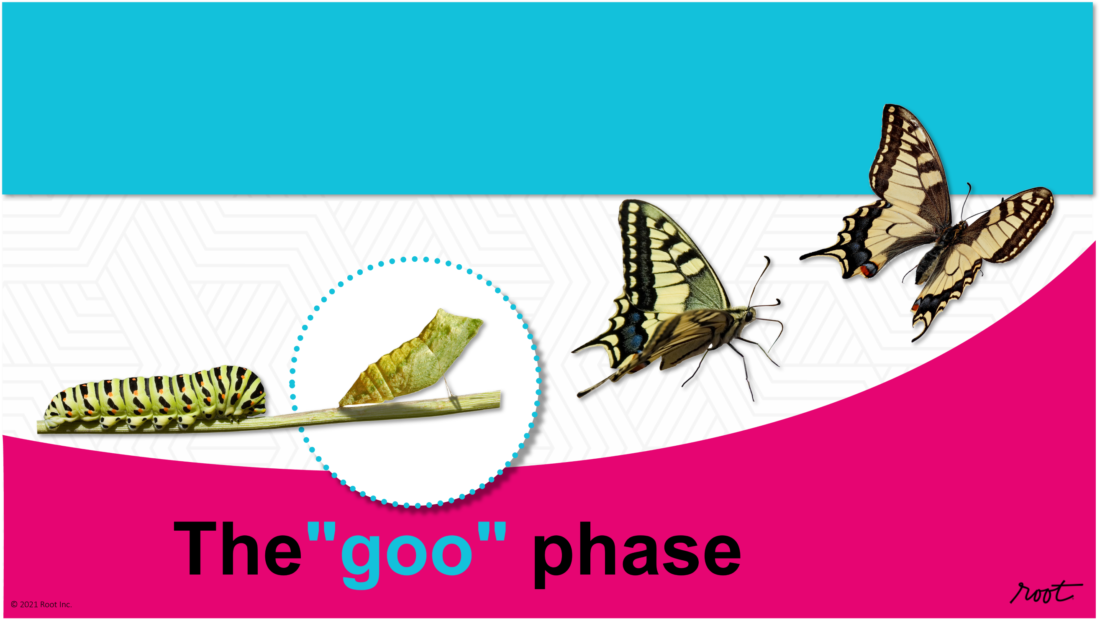I recently learned something fascinating about metamorphosis. When a caterpillar becomes a pupa, it builds its cocoon and then uses its own digestive enzymes to completely liquify its body. The caterpillar becomes a DNA-filled goo that reorganizes itself into a butterfly. When it’s ready, it breaks out of the cocoon, and off it goes. That’s wild!
When I reflect on organizational transformations, the analogy holds. Every transformation has a “goo phase” – and it’s usually the longest part of its life cycle, just like in nature. In this goo phase, we’re not what we were, but we aren’t what we will be (our future state) yet, either. And, as in nature, if you were to peek inside during this stage without knowing what you were looking at, it wouldn’t look like much like progress.
In transformations, we talk a lot about getting rooted in the current reality. We also talk a lot about our vision of the future. But we aren’t spending enough time talking about the goo phase. Why? Perhaps because it’s ambiguous, hard to describe, and even more difficult to measure. As a result, few people realize how valuable this stage is. I talk to dozens of end users of strategic change every year. When I ask about ongoing change efforts, a typical response I often hear is, “Oh, yeah – that thing. Whatever happened with that? Is it working?”
If we aren’t talking about the goo phase of a transformation, then our people won’t understand why this phase is fundamental to the process. People need to understand why it’s so important to stick with the change, especially during the (often uncomfortable) goo phase. Without the “goo,” change can’t happen, so leaders must educate and inform their people about this part of the change process. If your people don’t understand why things feel hard, they’ll likely think the initiative is a failure. They might begin to view the initiative as just another “flavor of the month” and gradually disengage, and then stop showing up for it entirely.
Connecting All the Dots and Defining the Goo
Here are three ways we can help our people through the goo phase and accelerate change.
- Keep context front and center.
Every time I ask stakeholders what they need to be successful, a clear articulation of “the why” always lands at the top of the list. Organizations have gotten really good at sharing “the way” when they announce change… and then they check the box as complete! But that context gets fuzzy when they enter the goo phase. The business continues to run, new initiatives and communications come out, the pain of change hits, and “the why” gets lost.
To keep eyes focused on the ultimate prize, context must be reinforced throughout the entire process, especially during the goo phase. What are we doing? Why are we doing it? How long will we be in this in-between stage? These are questions must be answered – and answered frequently – throughout the course of the change.
- Equip your managers to be change leaders.
Few people can influence your willingness to change more than your direct manager. Ensuring that managers are “skilled up” with change leadership capabilities will enable teams to work their way through the goo with less distraction. Improving a manager’s ability to focus their people on what they can control, be a listener and empathizer, and translate big change into real action for their teams will go a long way in bridging the gap between strategic vision and daily life.
Doing this well often means starting early – maybe before a major transformation is even on the docket. Developing change leadership muscles today means managers are able to more quickly get their arms around their role in future changes. Managers need to have the communication know-how to share messaging with their teams in a compelling, engaging manner. They also need a true understanding of the strategy as a whole, including the current reality, the goals for the future, and the roadmap to get there. When they have the box-top view that connects all the dots, functions, and roles, they can disseminate this information and keep everyone engaged, even when obstacles are faced and fatigue sets in.
- Maintain an ongoing dialogue.
When you ask end users why they felt a change initiative went well, they typically describe feeling energized and like they accomplished something. This is often because change leaders consistently updated them on progress from an organizational perspective and collected feedback on how it was going from an individual perspective. Leaders worked out milestones and celebrated the small increments that accumulated to become part of the larger transformation. This ongoing dialogue and continuous acknowledgement create a cycle – communicating, measuring and taking in feedback, making adjustments and communicating again – that maintains engagement and the change mindset over time.
It’s been documented beyond question that change can be difficult. It’s almost always scary, confusing, and frustrating. Perhaps it’s time to adjust our mindsets. Instead of accepting the hard times and committing to “sticking it out,” maybe it’s time to actually embrace the hard parts and to view the middle point of a transformation – the hard-to-define period where new behaviors have been adopted, but there isn’t a clear impact yet – as a success in its own right. Because this goo is essential. Without it, nothing will actually change.






